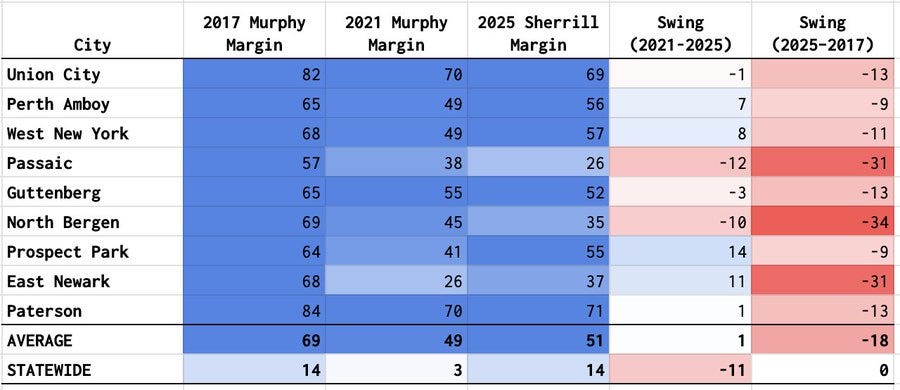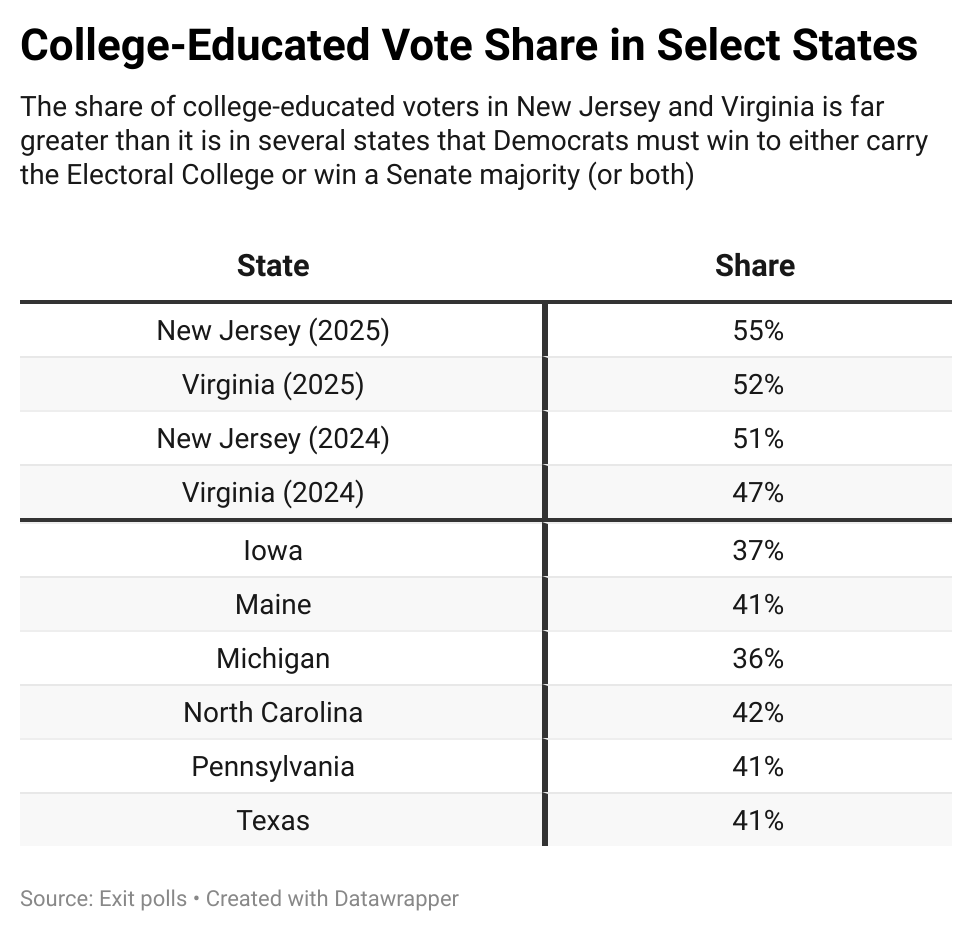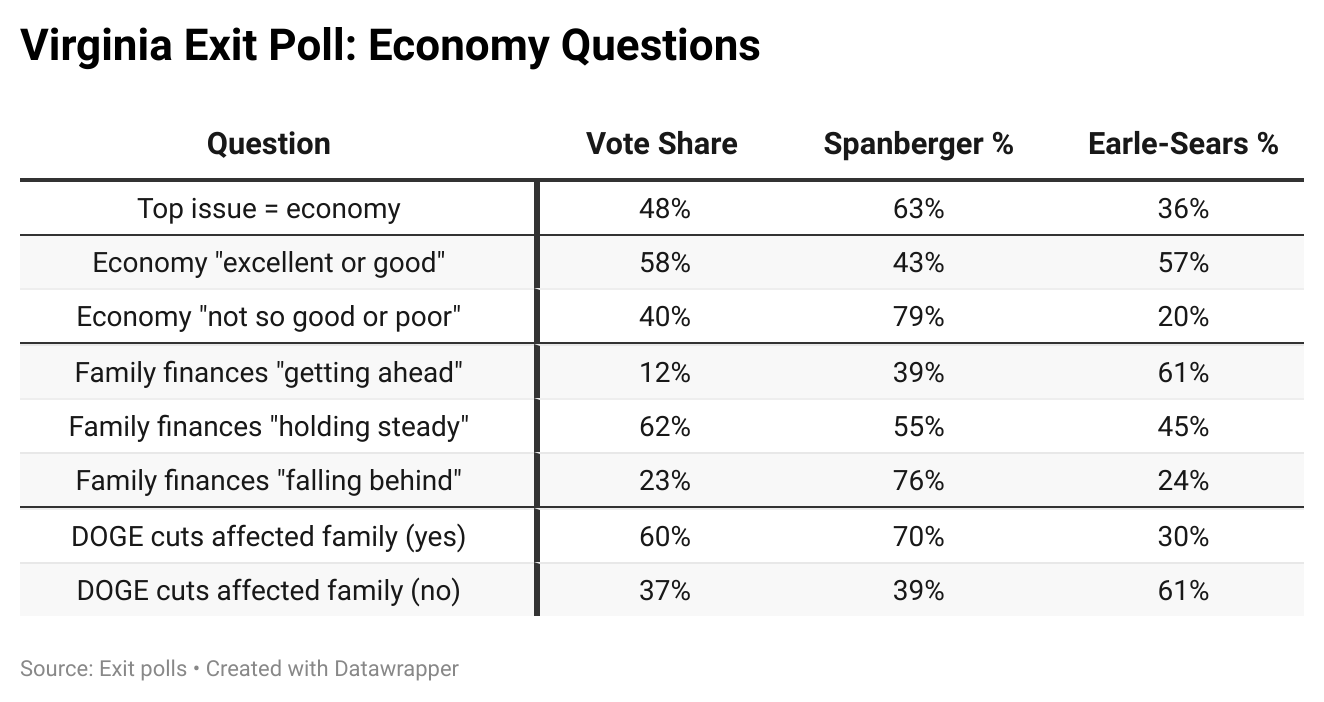Six Takeaways from Last Week’s Elections
A deep dive into election results in New Jersey, Virginia, and elsewhere.
Last week’s elections gave a jolt to the Democratic Party, which had largely been demoralized and directionless following their 2024 loss to Donald Trump. They won marquee races and made big gains down the ballot, too. The party can and should enjoy these victories, because regardless of what they portend for the future, they delivered power to them in the present, including in places like Virginia and Georgia, where coming into the election they had little to none.
It’s also imperative to be clear-eyed about these results and honest about what we do and don’t know. It wasn’t that long ago that Democrats learned the wrong lessons in victory and it cost them. So today, I will offer some assorted thoughts from the latest elections, including examining dominant narratives that have emerged since Tuesday night and determining how much stock to put in them.
An Important Caveat
Before diving into the results, it’s important to understand that this year’s electorate is quite different from the presidential electorate of last year. This may sound to some like stating the obvious, but it serves as a reminder that these results have limited generalizability vis-à-vis next year’s midterms and especially the 2028 presidential election.
Exit polls indicate that the electorates in New Jersey and Virginia were much more Democratic-friendly than they were last year. In both states, the share of voters who identified as Democratic or Democratic-leaning outpaced the share of Republicans and Republican-leaning voters by eight points. And in the 2024 recalled vote, respondents said they supported Kamala Harris for president last year over Donald Trump by eight points in New Jersey and nine points in Virginia—larger margins than Harris enjoyed last year in both states.
Additionally, both electorates were highly educated and affluent. In New Jersey, fully 55 percent of voters had a college degree against 45 percent who did not, while in Virginia that gap was 52 to 48. Not only did college degree-holders make up greater shares of the vote in each state than they did last year, but they constitute much larger shares there than they do in presidential swing states and others they’ll need to win for a chance at a Senate majority. Here is what the share of college-educated voters looks like in a few such states (per the 2024 results):
Suffice it to say, the voters who cast a ballot this year in these two blue states don’t reflect the higher-turnout electorates of either one—and they don’t come close to resembling what the median voter in battleground and right-leaning states looks like. This therefore limits just how much Democrats can and should can extrapolate from these results.
It’s Still (Mostly) the Economy, Stupid
It’s clear that a key driver of Democrats’ wins was the state of the economy. In 2024, voters for whom the economy was a primary motivating factor swung against the Biden-Harris administration, helping elevate Trump to a second term. However, since his return, many voters still feel squeezed by cost-of-living issues—and they’re now starting to turn on him.
In New Jersey, Virginia, and New York City, a plurality or majority of the electorate said the number one issue facing their state or city was the cost of living, and these voters broke overwhelmingly for the winning candidate. This was especially evident in Virginia, where nearly half (48 percent) of voters highlighted the economy as the number one issue—and they backed Democrat Abigail Spanberger over Republican Winsome Earle-Sears, 63 to 36 percent. She also carried voters who said that the economy was “not so good or poor,” those who said they were either “holding steady” or “falling behind” financially, and Virginians who reported that their family finances suffered due to the Trump administration’s DOGE cuts.
It seems that although voters hoped Trump would help get the economy back on track and return to the robustness of his first term, many are beginning to get impatient—and his party is paying a price.
Trump Was Also a Powerful Motivator for Democrats (but May Not Be for Much Longer)
Democrats’ aversion to Trump’s behavior and many of his policies was a powerful tool for buoying Democrats back to power in the early part of his first term, and it appears to have helped the party yet again. As I noted last week, roughly 40 percent of voters in both New Jersey and Virginia said one reason for their vote was to oppose Trump, and virtually all of them broke for the Democratic nominees. And in both states, nearly two-thirds reported feeling “dissatisfied or angry,” and they backed Spanberger and Sherrill by a margin of more than 50 points each.
But it’s worth noting a couple of things here. First, most of these voters were likely dyed-in-the-wool Democrats who were highly motivated to turn out and “vote blue no matter who.” Though they were no doubt important to Democrats’ victories, the candidates needed broader support to put them over the top, including from voters for whom Trump either wasn’t a factor in their vote or the economy was the most important issue—or both.
Spanberger and Sherrill seemed to understand this. The writer Derek Thompson recently got a hold of ad data from Blue Rose Research, which found that “the best-testing ads in both Virginia and New Jersey focused on affordability, tying rising costs to Trump and Congressional Republicans.” One topic that both Spanberger and Sherril largely avoided? MAGA. Even though Trump’s popularity has sunk, they understood that anti-Trumpism as a strategy increasingly offers diminishing returns and that many voters want more.
Secondly, it’s rather remarkable that even in such a favorable Democratic environment only about 40 percent of voters—and in two blue states, no less—said that even one reason for their vote was to oppose Trump. Meanwhile, a greater share (roughly 45 percent) said that Trump did not factor into their votes at all, and they broke for Republicans in both races. Spanberger and Sherrill likely won because they were still able to capture some of these voters.
But there’s a clear warning sign here: Democrats won’t be able to rely on opposition to Trump to win elections forever, especially in more competitive states. Given that his time in power will soon come to an end—and, thus, possibly his role as a motivator for some true-blue voters—Democrats will need a plan for making more inroads with that 45 percent.1
The Hispanic Vote Shifted Back—for Now
One of the most important trendlines of the Trump era has been the rightward shift of Hispanic voters, a topic we have long covered here at TLP. Between 2016 and 2024, exit polls show that Hispanic New Jerseyans swung an astounding 40 points toward Trump, with Harris winning them by just 13 points versus Hillary Clinton’s 53-point margin. Meanwhile, Virginia Hispanics moved right at a smaller but still notable rate, supporting Harris by 19 points after backing Clinton by 35.
This year, however, the competition for these voters was not close: Spanberger and Sherrill won Hispanics by 34 and 37 points, respectively, according to the exits. We also see this leftward movement in localities with relatively large Hispanic populations. Take Manassas Park, Virginia. Four years after voting for Biden by 33 points, Harris won it by only 19. But voters there who turned out this year backed Spanberger by 42 points—a larger margin than any presidential candidate of either party has enjoyed since 1984. Or look at Hudson and Passaic Counties in New Jersey: both swung heavily toward Trump in 2024 (he even flipped Passaic), and both swung either all the way back to Democrats or by even more this year.
However, beware suggestions that Democrats seem to have suddenly fixed their issues with these voters. One reason for skepticism: going slightly further back in time shows that Democratic support among Hispanics today remains well below their 2017 levels, when the party’s nominee for New Jersey governor, Phil Murphy, won by the same margin (14 points) as Sherrill. Pollster Patrick Ruffini examined how a handful of New Jersey municipalities that are at least 60 percent Hispanic performed in each of the previous three gubernatorial elections. He found that while some of them shifted back toward Democrats this year relative to 2021, Sherrill’s margins in all of them were lower than Murphy’s eight years ago. And in some cases, the gap was stark.
Vote Trends in New Jersey Municipalities that Are at Least 60 Percent Hispanic

Additionally, this year’s electorate is, again, fundamentally different from that of 2024. Based on recalled vote, Hispanic voters in Jersey this year supported Harris by 25 points (56–31) and in Virginia broke for her by 22 (58–36)—but her margins with them were 13 and 19 points, respectively. This means that the Hispanic electorate in 2025 was more Democratic-friendly than it was in the higher-turnout presidential election.
Finally, 2024 post-election analysis found that a lot more voters across racial and ethnic categories voted in line with their ideology, with just 17 percent of Hispanic conservatives favoring Harris nationally. Exit polls from New Jersey suggest that this trend may be holding, with only about three in ten conservative Hispanic voters backing Sherrill.2
Last week’s results should still give Democrats hope that they can win back at least some of the ground they have lost with these voters during the Trump era once he is out of the picture. But it would not be wise to assume their recent struggles are over.
Cross-Over Voters Helped Democrats
It may not have been decisive, but marginal shifts in support from right-of-center voters appeared to give both Sherrill and Spanberger a boost, a sign that persuasion was a key part of their path to victory rather than turnout alone. Consider:
In the 2024 recalled vote, both women received support from seven percent of Trump voters. While this may not sound like much, virtually no Harris voters threw their support to the Republican candidates. These voters’ decision to shift from Trump to the Democratic nominee essentially constituted a two-vote swing—one more for the Democrat and one fewer for the Republican.
Voters who “strongly approved” of Trump’s job performance voted almost uniformly for the Republican candidates while those who disapproved voted heavily for the Democrats. But a fraction of voters who “somewhat approved” of Trump supported Spanberger (13 percent) and Sherrill (19 percent).
The two women also won somewhat meaningful shares of self-identified Republicans (8–9 percent) and conservatives (10–11 percent). In both cases, these shares were higher than they were for Democratic and liberal voters who backed the Republican candidates.
The New York Times’ Nate Cohn added some more context to this, analyzing voter records from several New Jersey counties that are already available:
In these counties, Democrats had a roughly 19-point turnout edge by party registration, up from around a 16-point edge among 2024 voters. That’s a net 2.5-point shift (the figures are rounded), and largely consistent with what the exit polls found.
Alone, the net 2.5-point shift in party registration would not explain a nearly nine-point shift toward Ms. Sherrill in these counties (when compared with the 2024 vote for Ms. Harris). More sophisticated modeling, using Times/Siena poll data, shows a similar if slightly more pronounced pattern, with Ms. Sherrill gaining a net 3.5 points because of turnout alone—still not enough to account for her much bigger gains overall.
In other words, the voter records suggest the same thing the exit polls do: Ms. Sherrill benefited from Democrats’ improved turnout, but she benefited even more from flipping some of Mr. Trump’s 2024 supporters to her side.
Beware Claims of the Trump Coalition’s Demise
There is often a temptation—especially among partisans—to overreact to election results when one’s own side does well. So it should be no surprise that pundits have done as much this week, with some going so far as to suggest that the results of this election definitively show that the 2024 “realignment” is already over. Those hastily backing this narrative, however, should really know better than to make sweeping generalizations based on the results of a low-turnout, odd-year election.
Reality is more complicated. It is true that Republicans saw their political lives flash before their eyes this past week, capturing a glimpse of what it could look like if they fail to keep Trump’s coalition together. Specifically, as Vox’s Eric Levitz observed, they fear that “once Trump is gone—the college graduates whom he alienated will remain Democrats, while the disengaged voters whom he mobilized will stop turning out.” He adds that Republicans during Trump’s second term seem to be doing all they can to continue repelling college-educated voters who dislike him.
Yet, there are valid reasons to question whether Republicans are doomed once Trump’s term ends. More from Levitz:
Precisely because Democrats now have an advantage in lower turnout elections—Tuesday’s events might paint a misleadingly favorable picture of the party’s long-term prospects. When Democrats dominated 2023’s special elections, many in the party concluded that it was on track to beat Trump the following year. But this proved to be a mistake. The subset of voters who bothered showing up for off-year elections were simply much more Democratic than the electorate as a whole.
This same pattern could play out again. It’s possible that the GOP’s most disengaged supporters will only turn out for Trump. But an equally valid hypothesis is that they will only turn out for presidential elections—in which they will vote for any MAGA nominee on the ballot. Until Republicans nominate someone not named Donald Trump, we simply cannot know.
Moreover, the Republican coalition of less-engaged, working-class voters is more efficiently distributed throughout the country—especially the battleground states—than are the Democrats’ more highly engaged and educated voters. This leads to our final takeaway (for now)…
Democrats’ Structural Problems Remain
Finally, we return to a recurring TLP theme: the Democrats face a host of deep, structural woes and must address them if they hope to consistently vie for power over the long run. This includes:
Growing disadvantages in the Electoral College and Senate thanks to the concentration of their coalition in fewer and fewer states over time;
The depletion of their voter-registration rolls (and the corresponding growth of Republicans’ ranks);
The erosion of working-class support for them, which continued in 2025: even in this Democratic-friendly electorate, working-class whites, specifically, shifted even more rightward in both New Jersey and Virginia; and
A base that is moving further away from the median American in both demographic profile and ideology.
Democrats can celebrate their latest electoral wins for now. But there is still much work for them to do.
Of course, his absence may hurt Republicans as well, which I will expand on further down.
The exits did not capture how conservative Hispanics in Virginia voted this year.






Those elections last week may nothing one thing they do mean is that that socialist anti semite who became the mayor in New York will be an albatross around every Democrat in the midterm elections, and the Republicans will control the house and the Senate and of course the White House for another two years
Can't disagree with much of this. The only structural points I would add---and they are very significant---is that as deportations continue (already about 2m total), a Ds will lose a significant number of voters (ahem) from those. Second, as voter roll purges continue, that also will continue to shift things. To my knowledge, required voter roll purges have NOT yet taken place in two big CA counties, Orange and Los Angeles. Meanwhile, there has not been any sign yet of a voter registration shift slowdown working for Rs. Last week NC saw the D lead of 175,000 in 2020 fall to 6,000; PA fell again; NM showed a nearly 6,000 R gain/D loss since September. Seth Keshel ("Capt'n K's Corner") had a nice rundown last week of all these changes.